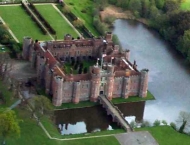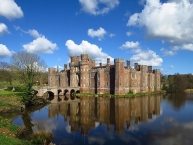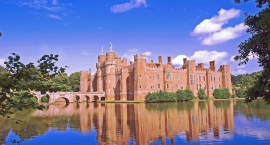Herstmonceux Castle
Worth visiting
Added on 22 Jan 2020,
last edited by »biroto-Redaktion« on 23 Jan 2020
Nearby cycle routes and tours
| Route name | Type | Dist. to route |
|---|---|---|
Route | 3,6 km | |
Tour | 0,1 km | |
Tour | 3,4 km |
![]()
Please wait - map data are loading
Type of sights
Castle/palace
Name and address
Herstmonceux Castle
Halley Road
GB-BN27 1RN Wealden
GEO-data
Geodetic coordinates
50.869500 0.338700
Elevation
14 m
Communication
Phone
+44 ∎∎∎∎ ∎∎∎∎∎
Internet
∎∎∎.∎∎∎∎∎∎∎∎∎∎∎∎-∎∎∎∎∎∎.∎∎∎/



Herstmonceux Castle is a brick-built castle, dating from the 15th century, near Herstmonceux , East Sussex, England. It is one of the oldest significant brick buildings still standing in England. The castle was renowned for being one of the first buildings to use that material in England, and was built using bricks taken from the local clay, by builders from Flanders. It dates from 1441. Construction began under the then-owner, Sir Roger Fiennes and then, from his death in 1449, by his son, Lord Dacre.
The parks and gardens of Herstmonceux Castle and Place are Grade II* listed on the Register of Historic Parks and Gardens. Other listed structures on the Herstmonceux estate include the Grade II listed walled garden to the north of the castle, and the Grade II* listed telescopes and workshops of the Herstmonceux Science Centre.
Early history
The first written evidence of the existence of the Herst settlement appears in William the Conqueror's Domesday Book which reports that one of William's closest supporters granted tenancy of the manor at Herst to a man named ‘Wilbert'. By the end of the twelfth century, the family at the manor house at Herst had considerable status. Written accounts mention a lady called Idonea de Herst, who married a Norman nobleman named Ingelram de Monceux. Around this time, the manor began to be called the "Herst of the Monceux", a name that eventually became Herstmonceux.
A descendant of the Monceux family, Roger Fiennes, was ultimately responsible for the construction of Herstmonceux Castle in the County of Sussex. Sir Roger was appointed Treasurer of the Household of Henry VI of England and needed a house fitting a man of his position, so construction of the castle on the site of the old manor house began in 1441. It was this position as treasurer which enabled him to afford the £3,800 construction of the original castle.
In 1541, Sir Thomas Fiennes, Lord Dacre, was tried for murder and robbery of the King's deer after his poaching exploits on a neighboring estate resulted in the death of a gamekeeper. He was convicted and hanged as a commoner, and the Herstmonceux estate was temporarily confiscated by Henry VIII of England, but was restored to the Fiennes family during the reign of one of Henry's children.
The profligacy of the 15th Baron Dacre, heir to the Fiennes family, forced him to sell in 1708 to George Naylor, a lawyer of Lincoln’s Inn in London. Bethaia Naylor, who became the heiress of Herstmonceux on the death of her brother's only daughter, married Francis Hare and produced a son, Francis, who inherited in turn, his mother's property. The castle eventually came into the possession of Robert Hare-Naylor, who, upon the nagging of his second wife, Henrietta Henckell, followed the architect Samuel Wyatt’s advice to reduce the Castle to a picturesque ruin by demolishing the interior. Thomas Lennard, 17th Baron Dacre, was sufficiently exercised as to commission James Lamberts Jnr of Lewes (1741-1799) to record the building in 1776. The castle was dismantled in 1777 leaving the exterior walls standing and remained a ruin until the early 20th century.
20th-century restoration
Radical restoration work was undertaken by Colonel Claude Lowther in 1913 to transform the ruined building into a residence and, based on a design by the architect, Walter Godfrey, this work was completed by Sir Paul Latham in 1933. The existing interiors largely date to this period, incorporating architectural antiques from England and France. The one major change in planning was the combination of the four internal courtyards into one large one. The restoration work, regarded as the apex of Godfrey's architectural achievement, was described by the critic Nikolaus Pevsner as executed 'exemplarily'.
Information about copyright | |
|---|---|
Rights characteristic / license | by-sa: CREATIVE COMMONS Attribution-ShareAlike |
Link to the description of the license | |
Input taken over from: |
Wikipedia contributors, 'Herstmonceux Castle', Wikipedia, The Free Encyclopedia, 10 December 2019, 05:54 UTC, https://en.wikipedia.org/w/index.php?title=Herstmonceux_Castle&oldid=930096454 [accessed 23 January 2020] |
taken over / edited on | 23 Jan 2020
|
taken over / edited by |
|
Hours of opening:
April to September 10am - 6pm
February, March, October & November 10am - 5pm.
Nearby cycle routes and tours
| Route name | Type | Dist. to route |
|---|---|---|
Route | 3,6 km | |
Tour | 0,1 km | |
Tour | 3,4 km |
Added on 22 Jan 2020,
last edited by »biroto-Redaktion« on 23 Jan 2020
